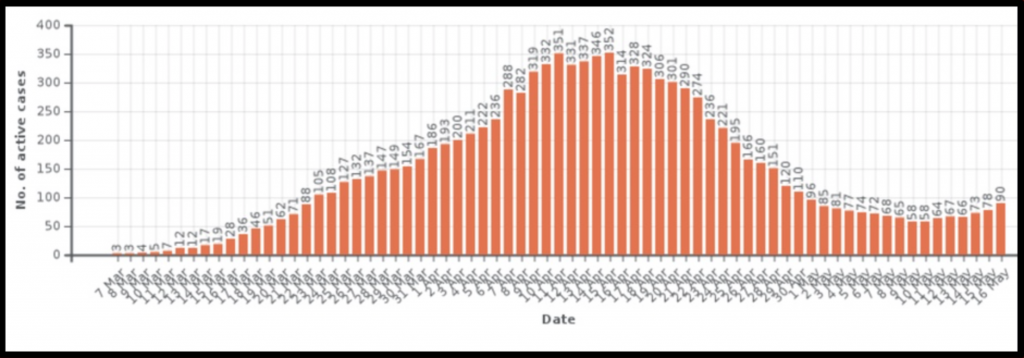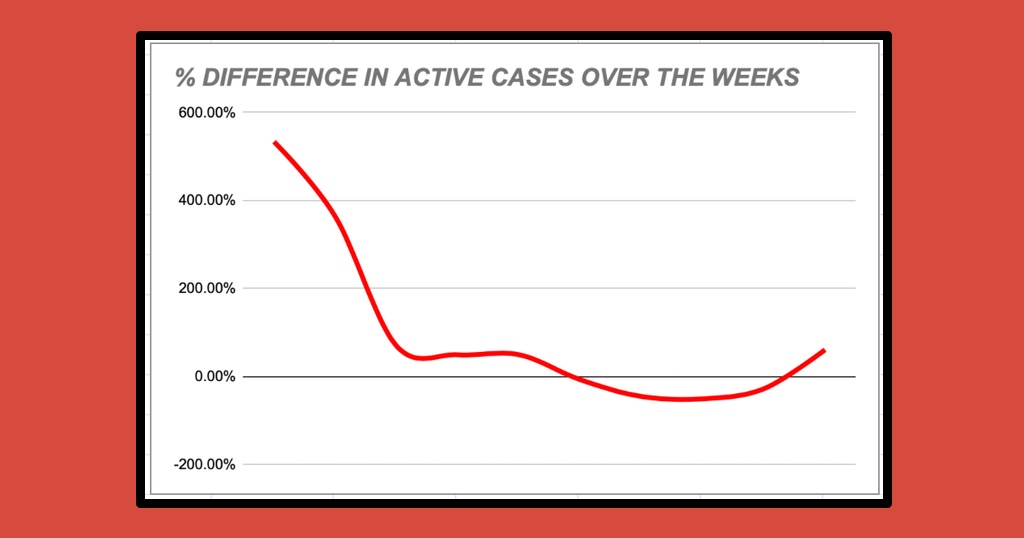Malta’s Active COVID-19 Cases Have Nearly Doubled In One Week. But What Does It All Mean?

From a purely statistical point of view, it’s tough to look at Malta’s current COVID-19 situation and not be at least slightly concerned. After all, the nation’s active cases have nearly doubled in just one week… a feat that’s only been exceeded in the first three weeks of this global pandemic. But is that a cause for concern?
On Sunday 19th April, exactly one week after a bulk of Easter recoveries, Malta woke up to some proper good news that would persist for four straight weeks.
For the first time since COVID-19 landed on our shores in early March, the islands finally registered a decrease in active cases over the course of a week. Sure, it was “only” a decrease of 25 cases (some 7.5%), but the wheels had been set in motion. The following week, active cases went down by a staggering 140. So with the curve solidly on its way down, Malta’s health authorities announced the lifting of certain measures, including the reopening of most non-essential retail stores, the resuming of travel between Malta and Gozo and an increase in maximum people allowed to congregrate in public. Then, two weeks later, as abruptly as it had arrived, the downward trend stopped.
Last Sunday, following an impressive 24-day streak of ever-decreasing infections, Malta’s active cases tallied 58, the lowest they’ve been since 19th March. By today, that figure is now standing at 93.
In other words, that’s a 60.34% increase over 12o hours.
For context, here’s what Malta’s active cases since Day One looked like as of yesterday.

See how that last part of the curve slowly starts going back up? That's where we are right now.
So how out of the ordinary is a 60%+ increase in cases over a week?
Well, it’s only happened three times before so far… in the initial wave that started this all and triggered the closures and cancellations of all of Malta’s shops and events.
Today marks the end of the 11th week since Malta’s first COVID-19 case was confirmed.
Since then, we’ve seen everything from a decrease of 51.20% in active cases over the first week of May (when it was announced that the measures would be lifted) to a meteoric increase of 533.3% on the first week of the pandemic’s arrival, when cases had shot up from 3 to 19. The next worst week was the one right after, when an increase from 19 patients to 88 saw a rise of 363.16%.
These ratios might look shocking, but are to be expected: it hadn’t been long enough for any restrictive measure to show its effectiveness, and it was still too early for anyone to recover. In fact, by the third week, you could see how effective the measures got, with weekly rises dropping from 363.16% to 69.32% (that’s when everything was cancelled and closed).
Then, by the time Malta’s active cases hit the triple digits and all shops had been closed for more than a couple of weeks, the percentage rise dropped, hovering at around 49% for two more weeks. Suddenly, we started marking decreases instead. And then, we got to this week.
Taking into account the percentage rise in active cases from one Sunday to the following Sunday, this week has been Malta’s fourth worst in the last three months.
For context, here’s what that all looks like from a bird’s eye view.

The rise and fall of Malta's active cases so far, every week since Day 1. Red marks a weekly increase in active cases, green a decrease

Of course, a couple of things need to be kept in mind when looking at this data.
Health authorities have repeatedly assured everyone that an upwards bump in cases was always expected. A number of factors have been attributed to this.
There is, for example, the matter of a sharp increase in tests being conducted every day, including random ones. Between Friday and Saturday, in fact, Malta broke all its previous records, carrying out over 1,700 swab tests. Yesterday, that number wasn’t too far off, standing at 1,429.
There’s also the added variable of all the shops that have now reopened, effectively acting as new potential places for infections to spread. This has already been seen to some extent, with a couple of yesterday’s cases coming from a retail shop and a take-away eatery.
However, the fact of the matter remains that you’ll only find COVID-19 cases if there are COVID-19 cases, and clearly, the virus is still very much in the community.
This has been something Public Health Superintendent Charmaine Gauci has stressed time and time again, urging caution and making daily pleas for social distancing rules to be respected and for people to try and refrain from going on too many non-essential outings.
Health Minister Chris Fearne has also confirmed and addressed this reality, stating that the country’s aim should be to reduce future incoming waves (because yes, that was always going to happen with a virus that still has no cure) into “streams”, instead of letting them intensify into “tsunamis”.
In the meantime, Malta is set to announce a slew of new openings next week, with Prime Minister Robert Abela earlier today reassuring everyone that “the only waves are in the sea”.